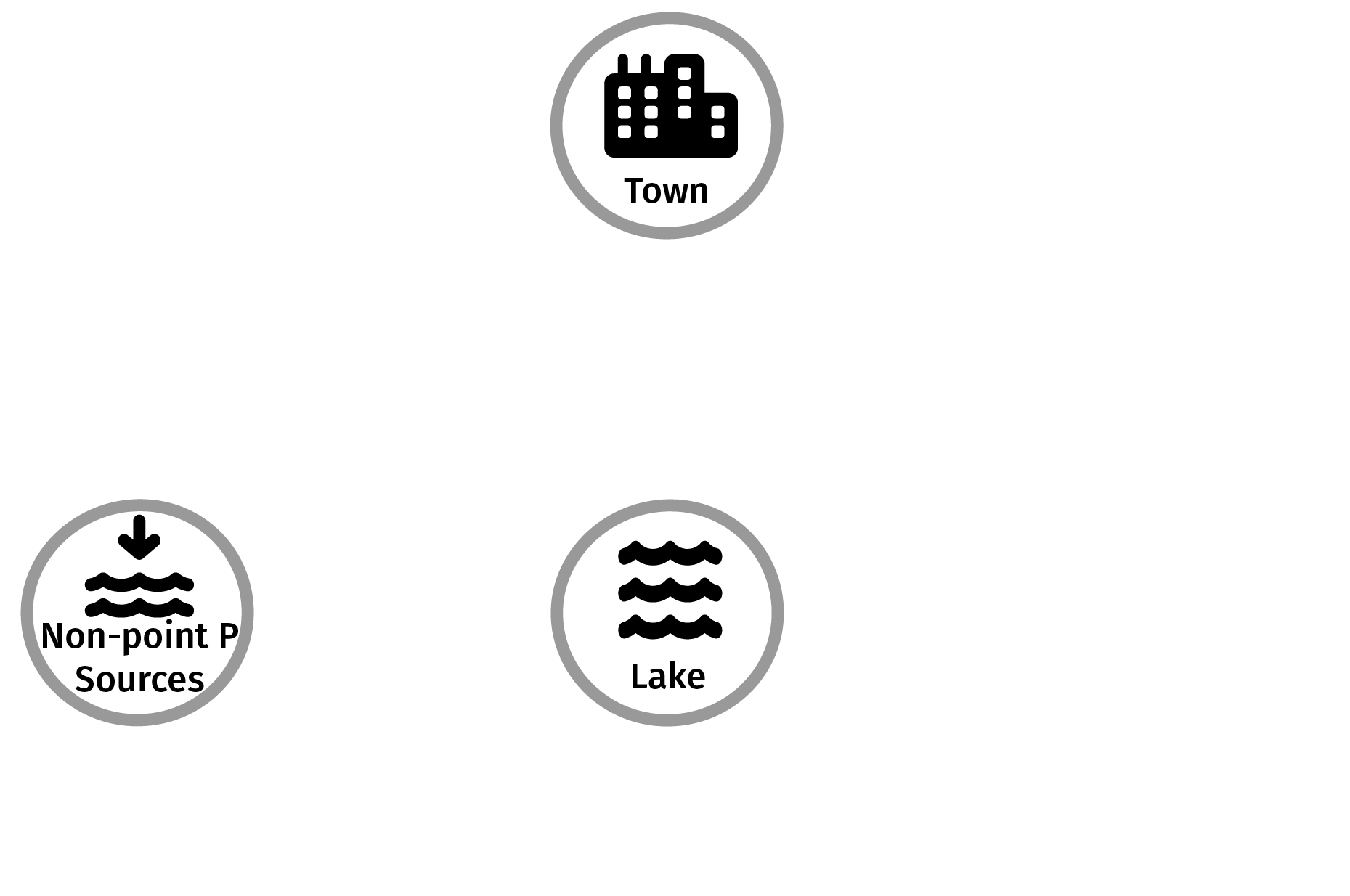class: center, middle .title[Introduction to Systems] <br> .subtitle[BEE 4750/5750] <br> .subtitle[Environmental Systems Analysis, Fall 2022] <hr> .author[Vivek Srikrishnan] <br> .date[August 22, 2022] --- name: toc class: left # Outline <hr> 1. Welcome! 2. Topics 3. Course Policies 4. Computational Tools 5. Course Communication 6. Tips for Success 7. *Intro to Systems* --- name: welcome class: left # Welcome to BEE 4750/5750! <hr> In this course, we will learn (using examples from environmental systems) how to: * Define systems and their boundaries * Simulate system dynamics using simulation models * Analyze and assess risk * Formulate and solve linear and nonlinear optimization problems * Explore trade-offs across competing objectives --- name: poll-answer layout: true class: left # Poll <hr> .left-column[{{content}} URL: [https://pollev.com/vsrikrish](https://pollev.com/vsrikrish) Text: **VSRIKRISH** to 22333, then message] .right-column[.centered[]] --- name: welcome-poll template: poll-answer ***What are you hoping to get out of this class?*** --- name: topics layout: false class: left # Course Organization <hr> 1. Introduction to Systems Analysis 2. Simulating Systems and Risk 3. Systems Management and Optimization 4. Analyzing Assumptions 5. *Decision-Making Under Uncertainty* --- name: policies class: left layout: true # Course Policies <hr> --- name: grades template: policies ## Grades * 35% homework assignments * 25% regulatory review project * 30% final project * 10% participation --- name: assessments template: policies ## Homework Assignments * Approximately 6 in total * Managed with GitHub Classroom (more on this shortly) * Submit on Gradescope by 9:00 PM on due date (probably a Thursday) * Collaboration encouraged, but **everyone must submit their own original work unless otherwise specified** * Late submissions penalized by 10% per day --- name: reg-project template: policies ## Regulatory Review Project * Requires researching an environmental regulation and modeling a relevant system * Will receive guidance from a Cornell librarian * **We will discuss this in class before you start** --- name: final-project template: policies ## Final Project * Group project for 4750, individual for 5750 * Work on applying and extending tools from this course to an analysis of a system of interest * Submit a poster and possibly a technical supplement * **We will discuss this in class before you start** --- name: office-hours template: policies ## Office Hours * Time TBD (watch for poll today) * 1x/week by Zoom (to start) * I *will* require mask wearing in my office –- it's not a big space! --- name: website template: policies ## Course Website * The website for this course is [https://viveks.me/environmental-systems-analysis](https://viveks.me/environmental-systems-analysis) * Includes course information, announcements, schedule, notes, demos, resources * **Make sure you check the site regularly!** --- name: communications template: policies ## Communications * Use [Ed Discussion](https://us.edstem.org) for discussions about class, homework assignments, readings, etc. * Try to use public Ed posts instead of email and private posts so others can benefit from questions. * But when privacy or urgency is essential, use whatever channel is appropriate. * *Announcements primarily through the course website and Ed Discussion* --- template: policies ## If You're Sick... * Please do not come to class if you're sick or contagious. Your recovery, and everyone else's health, are paramount. * We will make materials available on the website and GitHub, and will provide a Zoom link or recording if you need one. --- template: policies ## Masks * Masks are not required, per university policy. However, please be respectful of the distancing requests from others if you are unmasked. * I will wear a mask unless everyone else in the classroom is masked. *This policy may change later in the semester based on how case counts are progressing, my travel schedule, etc.* --- name: software class: left layout: true # Software Tools <hr> --- name: julia template: software ## Julia This course will use the [Julia programming language](https://julialang.org/). * Julia is a modern, powerful, fast language * Demos and tips available on the website * Familiarize yourself with the documentation and searching for answers to questions! * We will discuss and work on coding examples in class --- name: julia-poll template: poll-answer ***Programming language familiarity*** --- name: weave template: software ## Weave.jl Homework assignments will be written and compiled using `Weave.jl`. * `Weave.jl` is a package for literate programming which allows integration of text (Markdown) and code (Julia) in a single document. * Result can be easily compiled to HTML or a PDF. * We have an example code and document available. --- name: github template: software ## GitHub Classroom Access to assignments will be through GitHub Classroom. * You will be given a link to create a repository when an assignment is released. * PDFs of assignments *should* be auto-compiled when you `git push`. * Makes it easy to share code for feedback and debugging. * Let's look at [an example repository](https://github.com/BEE4750/hw0)! --- name: tips layout: false class: left # Tips for Success <hr> * Start assignments early! * Ask questions in class and on Ed and try to help your classmates * **Collaborate** — this is life as an engineer once you leave college! * But don't just copy, your work should reflect your own understanding. --- name: intro-systems-title class: center, middle <hr> # Introduction to Systems Analysis <hr> --- name: system-intro class: left # What Is A System? <hr> > A system is "an interconnected set of elements that is coherently organized in a way that achieves something...A system must consist of three kinds of things: *elements*, *interconnections* and *a function or purpose*." > > .cite[– Donella Meadows, *Thinking in Systems: A Primer*, 2008] --- class: left # What Is A System? <hr> In other words, **a system involves an interconnected set of components**, and analyzing a system involves **understanding the dynamics caused by those interconnections**. For examples, systems might have: * amplifying or dampening feedbacks; * thresholds and bifurcations; * emergent dynamics. --- name: systems-analysis class: left # Systems Analysis <hr> .left-column[## What We Study * System dynamics; * Response to inputs; * Alternatives for management or design. ] -- .right-column[## Needs {{content}} ] -- * Definition of the system * Systems model --- name: systems-def class: left # What Do We Need to Define a System? <hr> * *Components*: relevant processes, agents, etc -- * *Interconnections*: relationships between system components -- * *Control volume*: internal vs. external components -- * *Inputs*: control policies and/or external forcings -- * *Outputs*: measured quantities of interest --- name: systems-fig layout: true class: left # Example Systems Diagram: Lake Eutrophication <hr> --- .left-column[## Components Relevant "pieces" for the system ] -- .right-column[] --- .left-column[## Interconnections Relationships between components ] -- .right-column[] --- .left-column[## Control Volume "Boundary" between internal and external components and processes ] -- .right-column[] --- .left-column[## Inputs Additional external inputs: these may be control policies or forcings ] -- .right-column[] --- .left-column[## Outputs System outputs for monitoring or inputs into other systems ] -- .right-column[] --- class: left layout: false # System States <hr> We will repeatedly refer to the **state** of a system. This is vague, but the state includes quantities or variables which evolve over time based on external inputs and system dynamics. --- class: left # Stocks and Flows <hr> Two additional important concepts in systems analysis are **stocks** and **flows**. * A **stock** is the amount of a system property: concentrations of a pollutant, numbers of currency units, etc. * A **flow** is the way in which a stock changes: decay, diffusion, production, consumption, etc. Most systems analysis amounts to analyzing how flows across system interconnections impact stocks. --- class: left # Modeling System Flows <hr> For example: * Mass balance equations let us track changes in stocks at particular points; * Equilibrium conditions are requirements that there is no net flow, and thus that stocks are preserved; * Fate and transport modeling involves quantifying how stocks change as they move through the system. --- class: middle, left <hr> # Next Class <hr> * Mathematical Modeling of Systems * Work Through An Example * How Do We Know a Model Is Reliable?